Affiliate Marketing Funnel: How to Build & Automate Your Email List (2025)
I still remember my first month in affiliate marketing — I was posting links everywhere I could think of. Facebook groups, blog comments, Pinterest boards. I thought if I could just get enough clicks, the sales would follow.

They didn’t.
The truth hit me a few weeks later when I checked my stats — I had sent hundreds of people to my affiliate links… but when they didn’t buy, they were gone forever. No way to follow up. No second chance. No trust built.
That’s when I learned about affiliate marketing funnels — a way to collect emails first, then nurture your audience before selling. It was like turning a leaky bucket into a closed system where every drop counted.
Fast forward to today, and my funnels do the heavy lifting for me — whether I’m promoting web hosting with Hostinger, a Pinterest keyword tool like Pinclick, or my favorite free funnel builder, Systeme.io. With a well-built funnel, I’m not just chasing random clicks — I’m building an email list that buys from me over and over.
In this guide, I’ll walk you through exactly how to build your own affiliate marketing funnel — even if you’re starting from scratch. And yes, I’ll share the mistakes I made so you can skip the painful trial-and-error phase.
What is an affiliate marketing funnel and how do I build one? An affiliate marketing funnel is a step-by-step system that collects email subscribers, builds trust, and promotes affiliate products through automated emails. You can build one by creating a lead magnet, setting up an opt-in and thank-you page with a tool like Systeme.io, writing a value-first email sequence, and driving traffic using platforms like Pinterest with Pinclick or a blog hosted on Hostinger.
What is an Affiliate Marketing Funnel?
Think of an affiliate marketing funnel as a guided path you design for your audience — one that starts with curiosity and ends with a purchase (and ideally, more than one).
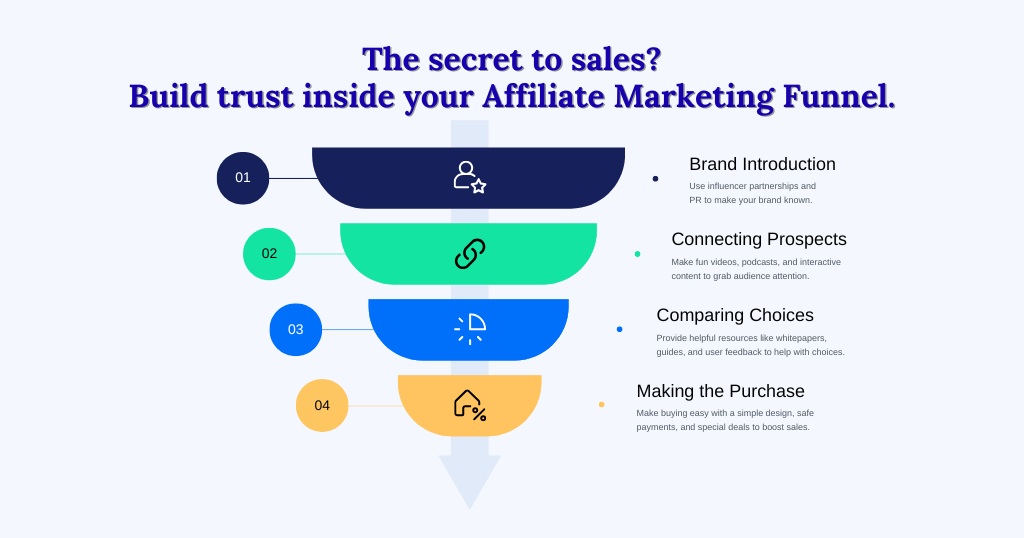
Instead of sending people straight to an affiliate link and hoping for the best, a funnel lets you:
- Collect their email address (so you can reach them again)
- Build trust through helpful content (so they see you as a problem-solver, not a pushy seller)
- Make your offer at the right time (when they’re warmed up and ready to buy)
Here’s the simplest version:
Traffic → Opt-In Page → Thank-You Page → Email Sequence → Affiliate Offer
For example:
- You create a freebie like “The 5-Step Pinterest Affiliate Checklist”
- Someone signs up on your Systeme.io opt-in page
- They get the checklist immediately, plus a welcome email
- Over the next week, you send 3–5 emails that educate, entertain, and subtly recommend your affiliate product — whether that’s Hostinger for building their first blog or Pinclick to get targeted Pinterest traffic.
The magic is that you own the audience. If they don’t buy today, you can email them tomorrow, next week, or even next month — for free.
Step 1 — Choosing the Right Lead Magnet
Your lead magnet is the “free gift” you offer in exchange for someone’s email address. It’s your first handshake with a new subscriber — and if it’s boring or generic, they won’t stick around long enough to hear your offer.
When I started, I made the classic rookie mistake: I created a 20-page PDF guide full of fluff. Hardly anyone read it, and my unsubscribe rate shot up. What I didn’t realize was that the best lead magnets are:
- Quick to consume (5–10 minutes)
- Immediately useful (solves a real problem fast)
- Relevant to the paid offer you’ll promote later
Some examples for affiliate marketers:
- Mini checklist → e.g., “7 Things Your Blog Needs Before Applying to Amazon Associates”
- Short video tutorial → e.g., “How to Find 10 Profitable Pinterest Keywords in 5 Minutes”
- One-page template → e.g., “Affiliate Email Sequence Swipe File”
💡 Pro tip: If your funnel is about building a blog or website, the natural upsell is web hosting. That’s why I recommend Hostinger — it’s affordable, reliable, and beginner-friendly. Your freebie could be a “Blog Launch Checklist” that smoothly leads into your Hostinger affiliate link.
The goal here is simple: Give them something that solves today’s problem while opening the door to a paid solution you earn commission on.
Step 2 — Building the Funnel Pages
Once you’ve got your lead magnet ready, it’s time to create the two core pages that make your funnel work:
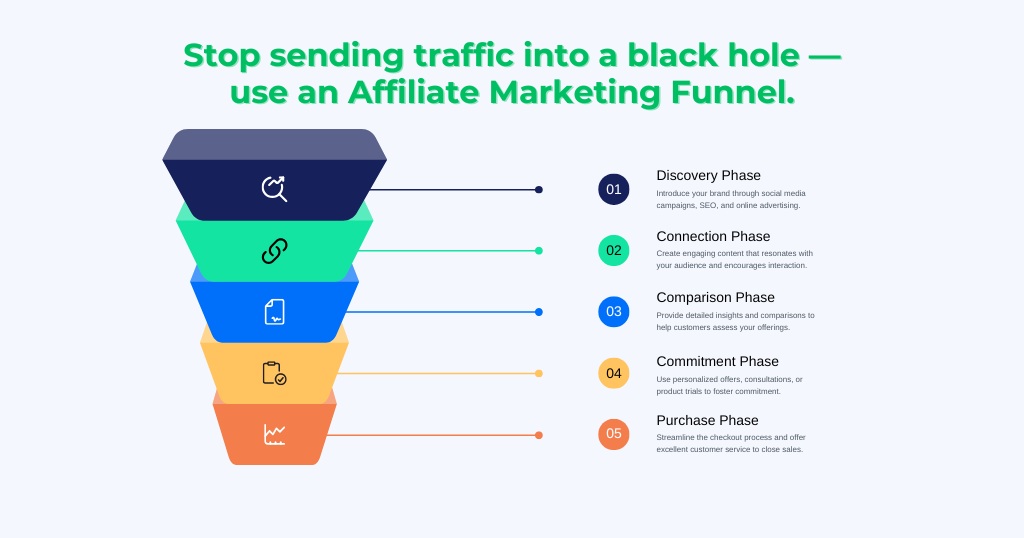
- Opt-In Page – Where visitors sign up for your freebie.
- Thank-You Page – Where you confirm their signup, deliver the freebie, and (optionally) introduce your first offer.
When I built my first funnel, I tried doing it manually with WordPress, plugins, and an email tool. It was a mess — nothing matched, my forms broke, and I wasted more time fixing tech than actually making money.
That’s when I switched to Systeme.io — an all-in-one platform where I could build my opt-in page, thank-you page, and email automation in a single dashboard. No extra plugins, no hidden costs, and no steep learning curve.
Here’s what to include on your Opt-In Page:
- Clear headline → “Get My 5-Step Affiliate Funnel Blueprint”
- Benefits list → Show how it solves their problem in plain language
- Image/visual → Mockup of your freebie or a lifestyle image
- Email form → Keep it simple (just name + email)
- No distractions → No menus, sidebars, or extra links
And your Thank-You Page:
- Thank them for signing up
- Give them instant access to the freebie
- Soft-sell or tease your paid offer (e.g., “Want to see exactly how I use this blueprint with my blog? Click here.”)
By setting these two pages up correctly, you’ll have a smooth entry point into your affiliate funnel — and more importantly, you’ll own every lead that comes through.
Step 3 — Crafting the Email Sequence
Your funnel pages collect the lead, but your email sequence is what turns them into a customer. Without it, you’ve just got a list of names — not a list of buyers.
When I wrote my first sequence, I crammed my affiliate link into every email. Bad move. People ignored me, unsubscribed, and I felt like I was shouting into an empty room.
The fix? Lead with value first, sell second.
Here’s a proven 5–7 email structure you can use:
- Welcome + Freebie Delivery
- Deliver the lead magnet instantly.
- Introduce yourself briefly (share a personal detail for trust).
- Hint at what’s coming next.
- Your Story + Soft Pitch
- Share how you struggled with the same problem they have now.
- Show the turning point (e.g., using Hostinger to launch a blog).
- Include a soft, no-pressure affiliate link.
- Pure Value Email
- Share a quick tip, checklist, or case study.
- No link, just goodwill.
- Problem → Solution Email
- Highlight a common roadblock.
- Position your affiliate product as the easiest fix (e.g., “I use Pinclick to find Pinterest keywords in seconds”).
- Strong Pitch with Urgency
- Special bonus, limited-time offer, or reason to act now.
- Include multiple links + clear CTA.
💡 Pro tip: Systeme.io can automate all of this so each subscriber gets your sequence in the right order — whether they join today or 6 months from now.
When your sequence is set up right, you’ll be waking up to emails that say “You’ve earned a commission” while you’re still sipping your coffee.
Step 4 — Driving Traffic to Your Funnel
You can have the most polished funnel in the world, but without traffic, it’s like setting up a beautiful store in the middle of the desert — nobody sees it.
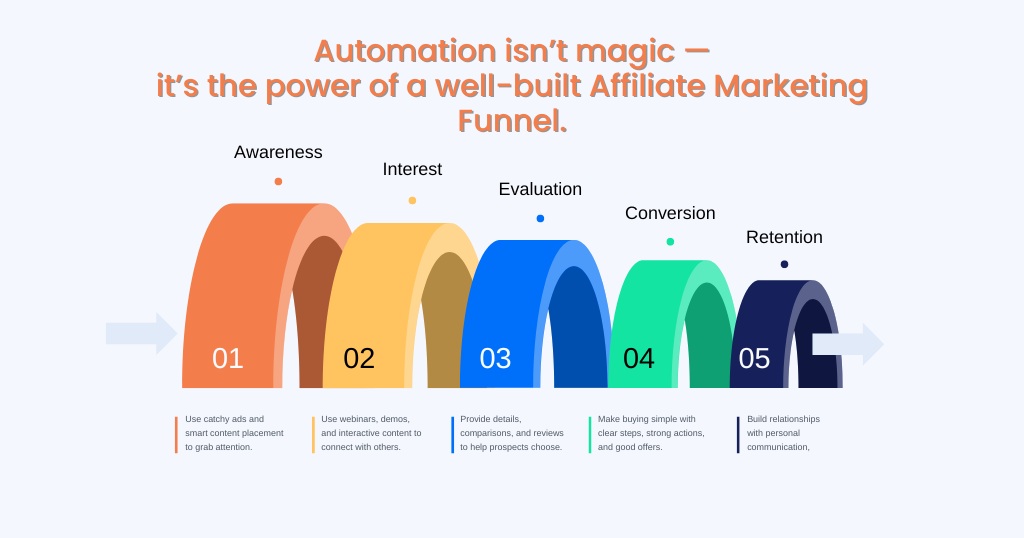
When I launched my first affiliate funnel, I made the mistake of relying only on friends, Facebook groups, and random blog comments. The result? A trickle of leads that barely covered my email tool subscription.
That’s when I built a traffic loop — a simple system that consistently brings new people into my funnel. Here’s what works best for affiliate marketers:
1. Free Traffic Sources
- Pinterest SEO → My #1 recommendation for beginners. Unlike social media posts that vanish in hours, a Pinterest pin can send traffic for months.
- How I boost this: I use Pinclick to find keywords people are actively searching for on Pinterest. Instead of guessing, I target exactly what they want, which gets my pins in front of the right audience.
- Blog Posts → Publish tutorials, reviews, and guides related to your lead magnet topic. Link your funnel naturally in the content.
- YouTube → Create short how-to videos that link to your opt-in page.
2. Paid Traffic Sources
- Facebook Ads → Great for quickly testing if your funnel converts. Start small and scale only when profitable.
- Native Ads → Platforms like Taboola or Outbrain can drive highly targeted traffic at scale.
3. My Traffic Loop Formula
- Pinterest sends traffic to my blog posts.
- Blog posts offer the freebie through my Systeme.io funnel.
- New subscribers get my automated email sequence promoting relevant affiliate products (like Hostinger, Pinclick, or other niche tools).
The goal is simple: set up at least one traffic source that works on autopilot so your funnel keeps growing even when you’re not actively promoting.
Step 5 — Tracking & Optimizing Your Funnel
Building your affiliate funnel is just the beginning. The real growth happens when you measure, tweak, and improve it over time.
When I first launched my funnel, I didn’t track anything beyond “Did I make a sale?” The problem? I had no idea where leads were dropping off — and I couldn’t fix what I didn’t understand.
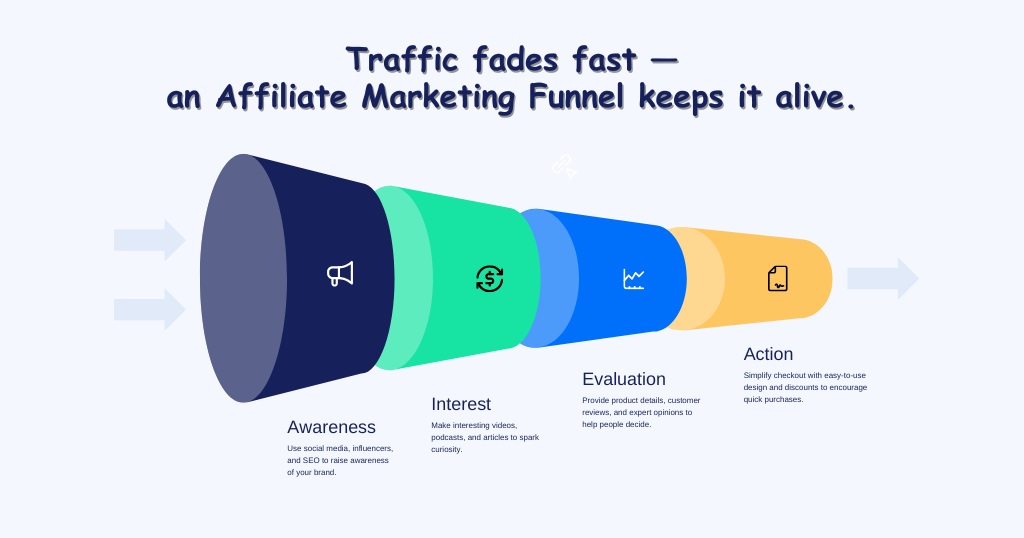
Now, I track a few simple but powerful metrics:
1. Opt-In Rate
- How many visitors sign up for your lead magnet?
- If it’s below 25%, test a new headline, image, or benefit list on your opt-in page.
2. Email Open Rate
- Are subscribers opening your emails?
- A healthy rate is 25–40%. If it’s low, test subject lines and send times.
3. Click-Through Rate (CTR)
- How many people are clicking your affiliate links in the emails?
- If CTR is low, make your links more visible and your CTAs more enticing.
4. Earnings Per Click (EPC)
- This shows how much each click is worth to you.
- Example: If you earn $100 from 200 clicks, your EPC is $0.50.
- Helps you decide how much you can spend on paid ads.
💡 Pro tip: Systeme.io has built-in analytics to track signups and email engagement, so you don’t need a separate tracking tool. Combine this with Google Analytics on your blog and you’ll have a clear picture of what’s working.
The goal isn’t to be perfect right away — it’s to make small, consistent improvements that compound over time. A 5% boost in opt-ins, a 3% increase in CTR, and a slightly better EPC can double your funnel income in just a few months.
Buy It / Don’t Buy It: Is an Affiliate Marketing Funnel for You?
| Buy It If… | Don’t Buy It If… |
| You want to build an email list that you own and control. | You’re looking for an overnight money hack without real effort. |
| You like the idea of automated income from an email sequence. | You hate the idea of writing or creating any type of content. |
| You want to sell multiple affiliate products to the same audience. | You only plan to share your affiliate links directly on social media. |
| You’re willing to test, tweak, and improve your funnel over time. | You’re not open to learning simple tech tools like Systeme.io. |
What I Wish I Knew Before Building My First Funnel
When I look back at my early days in affiliate marketing, I can’t help but laugh — and cringe — at the mistakes I made. If I had known these lessons sooner, I would’ve saved months of trial and error.
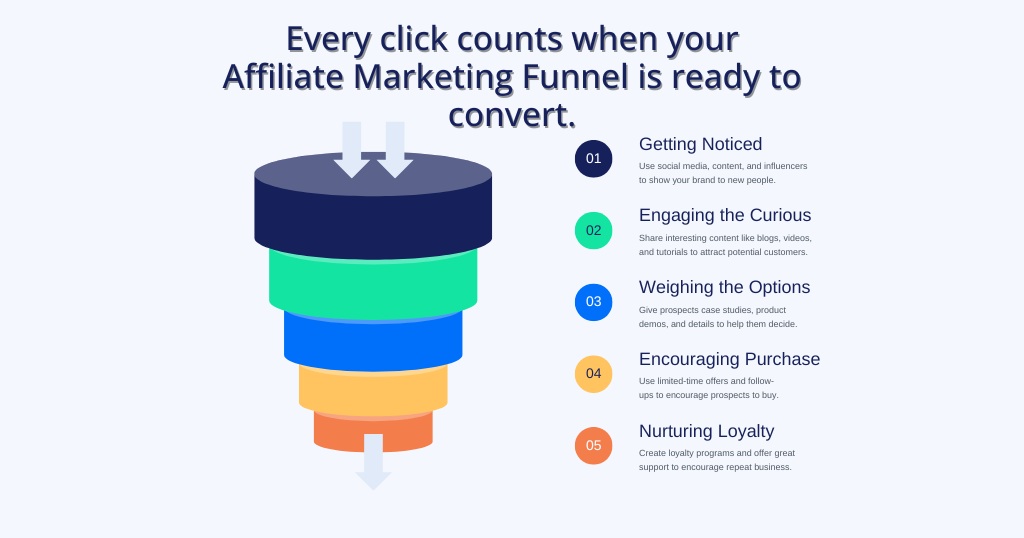
1. Sending Traffic Directly to Affiliate Links Is a Dead End
In my first month, I sent hundreds of clicks straight to my affiliate offers. When people didn’t buy, that was it — they were gone forever. No second chance, no follow-up. An email funnel fixes this by keeping you connected to your audience.
2. Not Every Freebie Works as a Lead Magnet
I wasted weeks creating a 20-page “Ultimate Guide” that nobody read. The best lead magnets are short, specific, and solve a single urgent problem.
3. Emails Sell Best When They Build Trust First
I used to pitch in every email, thinking more links = more sales. In reality, my best-converting sequences are the ones where I give 2–3 value-packed emails before I make a strong pitch.
4. The Tools You Use Matter More Than You Think
I tried piecing my funnel together with free tools, and it turned into a tech nightmare. Now I use:
- Systeme.io to build and automate my funnel
- Hostinger to host my blog and attract organic traffic
- Pinclick to drive targeted visitors from Pinterest
5. Small Tweaks Create Big Results
It’s tempting to think you need a total overhaul when your funnel isn’t working. But more often, a better headline, stronger email subject line, or clearer CTA can turn things around.
The sooner you learn these lessons, the faster you’ll go from “hope marketing” to having a predictable, income-generating system.
Final Verdict: Your Funnel Is Your Future
Affiliate marketing without a funnel is like trying to fill a bucket with holes — no matter how much traffic you pour in, most of it leaks out. But with an affiliate marketing funnel, you’re not just chasing clicks — you’re building a loyal audience that buys from you again and again.
The process isn’t complicated:
- Create a simple lead magnet
- Build your opt-in and thank-you pages
- Craft a trust-building email sequence
- Drive targeted traffic
- Track and tweak for better results
With the right tools, you can have your funnel up and running in days — not months. Here’s what I recommend to get started:
- Systeme.io – Build your entire funnel and automate your emails in one place.
- Hostinger – Launch a blog to drive organic traffic and capture leads.
- Pinclick – Find Pinterest keywords that bring free, targeted visitors to your funnel.
💡 Remember: Your email list is the one thing you fully own in the online world. Every subscriber you add is an asset that can pay you for years to come.
So, stop sending traffic into a leaky bucket. Build your funnel today — your future self will thank you.
Affiliate Disclosure Statement– This post contains affiliate links, which means I may earn a commission if you click through and make a purchase — at no extra cost to you. I only recommend products and tools I personally use and trust.
FAQ
What is an affiliate marketing funnel?
An affiliate marketing funnel is a step-by-step system that collects leads (usually through a freebie), builds trust via email, and promotes affiliate products in a structured way — increasing your chances of making sales.
Do I need a blog to create an affiliate funnel?
Not necessarily. You can build a funnel without a blog using tools like Systeme.io, but having a blog hosted on Hostinger can help you attract free organic traffic and capture more leads.
How long does it take to set up a funnel?
If you already have your lead magnet ready, you can set up a basic funnel in 1–3 days. Tools like Systeme.io make it easier because you can create pages, emails, and automations in one place.
Can I use free traffic to grow my affiliate funnel?
Yes! Free traffic sources like Pinterest, when combined with keyword tools like Pinclick, can bring consistent leads without paying for ads.
What’s the difference between sending traffic directly to an affiliate link vs. a funnel?
Direct linking sends people to the product page once and then you lose them. A funnel collects their email first so you can follow up with multiple offers, building a relationship and increasing your sales over time.
